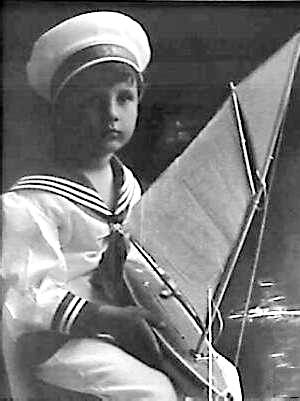
Figure 1.--This Seattle boy was photographed in his sailor suit with his sail boat. Note the traditional stripe detailing. |

|
The standard sailor blouse was the V-front middy blouse with a striped detailing on the collar and back flaps. While stylish, the open sailor collar was comfortable to wear. This is the blouse style that comes to mind when most people think of middy blouses and sailor suits. Detailing elements of middy blouses varied. The most common was certainly stripes. Some blouses did not have stripes, but the stripes were very common. The number of stripes varied. The basic three stripes were by far the most common, but the number of stripes could vary. Traditional suits, meaning the outfits most closely following naval uniforms, had three stripes. The three-stripe stripe detailing is a Royal Navy style adopted by the U.S. Navy. Some American blouses had stars added to the corners back flap. This was a specificically American innovation. White suits normally had dark blue detailing and colored (mostly blue) suits had white stripes. There were other alternatives. We note quite a number of plain collars. There were also collars done with patterened material. These were less common, but we see a number of examples in the photographic record.
The standard sailor blouse was the V-front middy blouse with a striped detailing on the collar and matching back flaps. While stylish, the open sailor collar was comfortable to wear. This is the blouse style that comes to mind when most people think of middy blouses and sailor suits. Detailing elements of middy blouses varied. The most common was certainly stripes. Some blouses did not have stripes, but the stripes were very common. The number of stripes varied. The basic three stripes were by far the most common, but the number of stripes could vary. Traditional suits, meaning the outfits most closely following naval uniforms, had three stripes. The three-stripe stripe detailing is a Royal Navy style adopted by the U.S. Navy. Some American blouses had stars added to the corners back flap. This was a specificically American innovation. White suits normally had dark blue detailing and colored (mostly blue) suits had white stripes. We see middy blouses done with various numbers of stripes, but the three-stripe detailing was the most common.
We note middy blouse collars that were plain without any detailing. Here we mean bloses done with a plain flat collar. These plain middy blouses were often considered an elegant variant to stripe detailing. There were two basic kinds of plain collars. First, Some collars were the same color as the body of the middy blouse. This is a little tricky because some blouses had sripes embroidered in the same color as the colar rather than a contrasting color. Second, other collars were done in contrasting colors. Middy blouses were done in various colors. These plain collars were usually the dark blue or white middy blouses, butvwe do see some other colors. The back flaps always matched the front collar colors. This is often difficult to assess given the black-and-white photography of the day. They were usually worn with with dickies. And while the collar did not have the traditional stripes, the dicket often had an embroidered design of various motifs.
Thie sailor blouse done with patterns were a variant of the plain collar blouses. There was no stripe detailing on the collar either. The material used for the middy blouse, however, was not a plain flat color, but rather some kind of patterened material. The actual patterns used varied with the creatiity of the mother, but could be quite bold ones, including plaids and checks. These look a strange because the patterns present a rather non-sailor look even though the cut odf the suit is that of a sailor suit. While the collar did not have stripes, the dickey worn with it often had an embroidered design.
We also notice patterns that were only used on the collar. Here the patterned material was just used on the collar without any further detailing. Again the actual patterns could vary. We notice patterns like polka dots and plaids. This option was not very common, but we do notice them. It seems, however, the least common of all the various collar detailing options.The actul placeof the patterened material varied. They seem most common around the turn of the 20th century in the 1890s and 1900s. This was collar detailing normally used for younger boys. Older boys would probably not like such destinctive styling.
Sailor Suit Country Related Pages:
[Return to the Main U.S. middy blouse collar detailing page]
[Return to the Main U.S. middy blouse page]
[Return to the Main U.S. individual sailor suit garment page]
[Return to theMain U.S. sailor suit garment page]
[American]
[English]
[French]
[German]
[Italian]
Other Related Pages:
[Sailor suits]
[Kilts]
[Smocks]
[Pinafores]
[Sailor Hats]
[Blouses]
[Ring Bearers]
[Long hair]
[Ringlet curls]
[Hair bows]
[Bangs]
[Collars]
[Bows]
Navigate the Boys' Historical Clothing Web Site:
[Introduction]
[Activities]
[Biographies]
[Chronology]
[Clothing styles]
[Countries]
[Bibliographies]
[Contributions]
[FAQs]
[Glossaries]
[Images]
[Links]
[Registration]
[Tools]
[Boys' Clothing Home]
